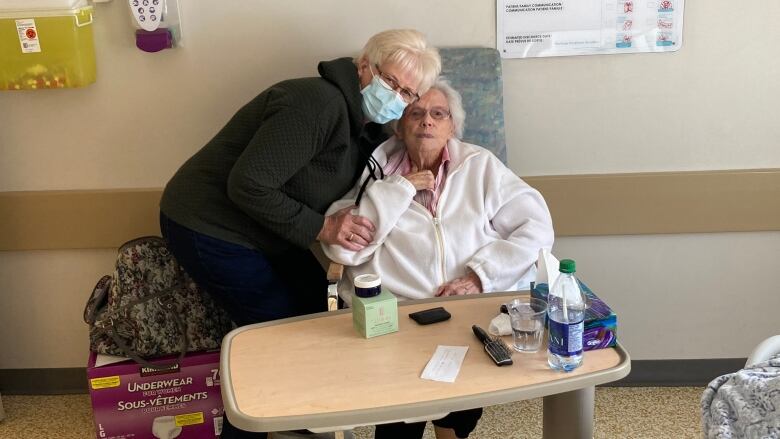After 100 years in Stonewall, Manitoba senior transferred out of town to make room for COVID-19 patients
Transfers are meant to ease pressure on health-care system strained by pandemic's 4th wave: Shared Health

Ruth Sampson has known no other home in her 100 years of lifethan Stonewall, Man. until this week, when thecentenarian was transferred, against her wishes, to a hospital in a communitymore than two hours away.
She is one of the Manitobans and perhaps the oldestforced from hospitals to make room for anexpected influx of COVID-19 patients during the province's fourth wave of cases.
Her family worries their Auntie Ruth may die alone. Time isn't on their side.
"Here's a lady that has lived in this community for 100 years, paidtaxes here for 100 years, and basically it's like getting the punt when you're 100 'we don't need you here anymore,'" saidDavid Tyerman, a family member.
Sampson had been living on her own, with minimal home care,at a 55-plus centre in Stonewall, about 30 kilometres north of Winnipeg, until she suffered a fall just before Thanksgiving and was brought to hospital.
She spent 46 days there, beforeher family was told on Tuesday that her bed had to be made available for a potential COVID-19 patient and Sampson would be sent to Crystal City.
'She's a trouper'
She took it all in stride, Tyerman said.
"She's a trouper. That's one thing about her," he said.
His wife, Linda Tyerman, is Sampson's niece. She saidher aunt's thoughts are with her familymaking the longtrek toCrystal City, a drive that's more than 200 kilometres southwest from Stonewall.
"She'sworried about we'regoing to be on the road at wintertime, and on the road when it's dark out. She's worried about the kids and what they're thinking," said Linda, who is her aunt's primary caregiver.
The couple say this issue extends far beyond them. Two dozen patients and counting have been transferred away, sometimes hours away from their loved ones.
"It's not just Ruth," Linda said.
Shared Health has said the transfers are meant to help ease increased pressureon the health-care system due to the spike of COVID-19 cases.
The provincial health organizationacknowledgesmoving individuals to sites in other health regionscan be unsettling and disruptive for both patients and their families.
During the legislature's question periodon Thursday, NDPLeader Wab Kinewmade reference to Sampson's forced transfer.
The Oppositionleader who is self-isolating after a COVID-19 diagnosis and appeared in question periodvirtually said the transferis proof the Progressive Conservative government has failed to prepare the health-care system for the latest wave of the pandemic.
"The family, I think, is rightfully upset because their loved one is not only going to be farther away from visiting, they're going to be farther away from their primary caregiver," Kinew said later in an interview.
Sampson is scheduled to be placed in a personal care home, although no timeline has been settled.
Progressive Conservative House leader Kelvin Goertzen said the pandemic has exacerbated the need for personal care home beds.
Resources needed for seniors: health authority
David Matear, chief executive officer of the Interlake-Eastern Regional Health Authority which includes Stonewall said the decisions to move people like Sampsonhave been difficult to make, and he sympathizes with families affected.
"I completely understand the frustrations," Matear said.
But as hospitals continue to feel the strain of the fourth wave, it's become necessary to move people who don't need acute care out of beds to ensure there's room for those who do.
Meanwhile, most personal care homes in the region are alreadynear full capacity.
"Unfortunately, that means that quite simply, we just don't have the beds," he said.
So far, 21 patientshave been transferred out of the health region, Matear said.
While more care home beds might seem like an immediate solution, other steps like expanding home care services and building more capacity in assisted living settings could actually be more beneficial down the road, he said.
"It's a difficult formula to look at, or calculation to make, when those other levels of care haven't been fully supported to the degree to which we'd like to see in the region," he said.
"I'm being simplistic here, but if we're only depending on acute care or [care home] beds, then it looks like we need an awful lot more [care home] beds.
"But actually, if we look at the needs of the patient and try to develop and transform the health-care system to meet those needs, the likelihood is we don't need as many [care home] beds, but we do need beds and capacity in other parts of the health-care system."












_(720p).jpg)


 OFFICIAL HD MUSIC VIDEO.jpg)
.jpg)



























































































